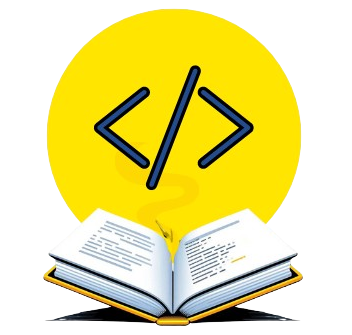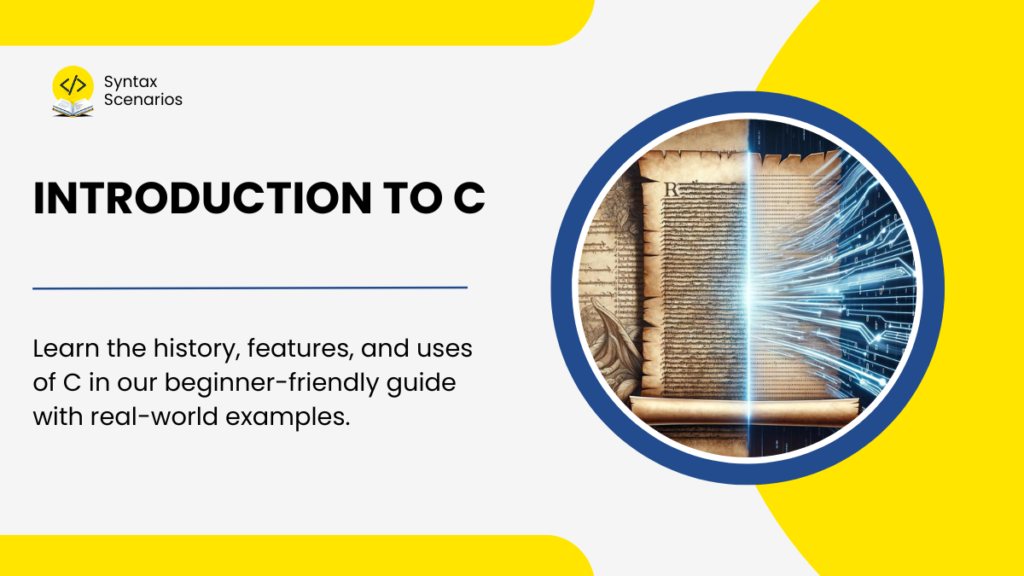Learn the history, features, uses, statistics and popularity of C language in our beginner-friendly guide with real-world examples.
Table of Contents
- History of C
- Features of C Language
- Popularity in Industry Surveys
- Statistics on usage
- Difference between C and C++
- Conclusion
- FAQs
C is a high-level, general-purpose programming language originally developed by Dennis Ritchie at Bell Labs of AT&T (American Telephone & Telegraph), located in the U.S.A. in 1972.
It is one of the most popular programming languages and is considered as a base for other languages, that’s why it is called the “mother language”. It is widely used in today’s systems for multiple reasons including;
- System software development (Linux, Windows kernel etc.)
- Embedded systems (IoT devices and automotive systems)
- Performance critical applications (applications requiring high performance such as real-time systems etc.
History of C
C is a successor of B language, which was typically an improvement of earlier BCPL (Basic Combined Programming Language) developed by Ken Thompson in 1969–1970 at Bell Labs, specifically designed for Unix operating systems.
B had some shortcomings and limitations regarding its portability and efficiency. Its overcoming and evolution resulted in the creation of C, a more powerful and flexible language.
ANSI (American National Standards Institute) in 1983 established a committee to standardize C resulting in ANSI C standard also known as C89 or C90. This standardization guaranteed the language’s broad acceptance and portability while also strengthening its syntax and semantics.
Features of C Language
Procedural programming
C supports a procedural programming paradigm, allowing a step-by-step approach to solve a specific problem which is achieved with the help of functions, sequential execution, and structured programming.
Think of procedural programming like following a recipe to bake a cake. You have a set of specific, sequential steps (functions) that you follow one after the other (sequential execution) to achieve your final product: the cake (solving a specific problem).
Rich library
Consider C’s rich library as a fully stocked pantry in a bakery. Just like a baker has access to a variety of pre-measured and ready-to-use ingredients—like flour for bread, sugar for cakes, and chocolate chips for cookies.
C’s libraries provide a wide range of pre-written codes for common tasks, such as mathematical calculations. This makes it easier for beginners to build programs without having to reinvent basic tools each time
Portability
Imagine C’s portability like a recipe that works well in any kitchen around the world. Whether you’re baking in a high-altitude mountain area or a humid coastal city, this recipe adapts with little to no adjustments.
Similarly, programs written in C can be compiled and run on different systems—from a Windows PC to a Linux server—with minimal or no changes. This makes C an excellent choice for developing cross-platform applications, as it ensures that your code remains adaptable and functional across various computing environments.
Popularity in Industry Surveys
In numerous industry surveys and indices, C is constantly ranked as one of the most widely used programming languages. For example:
C is frequently ranked in the top 5 or top 10 programming languages by The TIOBE Index, which measures language popularity based on search engine searches. According to 2023 statistics, one of the largest surveys of software developers The Stack Overflow Developer Survey constantly lists C as one of the most popular and widely used languages.
| Programming Language | TIOBE Index Rank | Stack Overflow Rank |
| C | Top 5 | Top 10 |
| Java | Top 3 | Top 5 |
| Python | Top 3 | Top 3 |
| C++ | Top 5 | Top 10 |
| JavaScript | Top 5 | Top 2 |
Statistics on usage
While specific statistics of software written in C compared to other languages may vary, C remains prevalent across various domains.
In embedded Systems
C-programmed embedded systems are widely utilized in industrial automation applications, such as robotic arms, PLCs (Programmable Logic Controllers), and process control systems. Devices that use embedded systems are powered by C including:
- Washing machines
- ATMs
- Microcontrollers
- Digital cameras
- Smart TVs
- Routers
- UAVs (Unmanned Ariel Vehicles)
- GPS systems etc
In Operating Systems
Because of its portability, low-level hardware access, and efficiency, C is widely utilized in operating system development. Operating systems use C in kernel development, device drivers, and system libraries.
- UNIX and UNIX-like Systems: UNIX, one of the earliest operating systems, was written in C. Its derivatives, such as Linux, FreeBSD, and macOS (based on Darwin, which is Unix-like), are also predominantly written in C. These operating systems use C for kernel development, system utilities, and many other components.
- Windows: While Windows is not primarily written in C, a significant portion of its core components, including the Windows kernel and many system services, are implemented in C and C++. The Windows NT kernel, for example, is written in C.
- Real-time Operating Systems (RTOS): RTOSes like VxWorks and QNX often have their kernels and core components written in C to provide real-time capabilities and efficient resource management.
Python Interpreter
Interestingly, Python’s interpreter (a program responsible for converting the human level code to machine-understandable code line-by-line) is written in C itself! which means that it is responsible for executing Python programs like a powerful engine inside a car.
Difference between C and C++
| Aspect | C | C++ |
| Purpose of development | C was designed initially for programming operating systems. | Its development covers a wide range of applications system/software development, game development, and large-scale projects. |
| Developer | It was developed by Dennis Ritchie in 1972 at Bell Labs. | It was developed by Bjarne Stroustrup in 1979. |
| Paradigm | C is a procedural programming language and follows a top-down approach. | C++ is both a procedural and object-oriented programming language and follows both the top-down and the bottom-up approach. |
| Security | C lacks security features hence external parties can modify it. | C++ is a secure language because it contains features like encapsulation and data hiding. |
| Syntax | C has a simpler syntax and fewer keywords and structures. | C++ expands on the syntax of C and adds more keywords and functionalities. |
| Compatibility | Programs or code written in c can be easily incorporated in C++ | C++ is not completely backwards compatible with C, because of its extra additional features |
| Data types | C supports built-in data types | C++ supports both built-in and user- defined data types |
Conclusion
To sum up, C programming is still an important component of computer science, affecting programmers’ workflow and being vital in the development of software. Because of its significance, developers worldwide need to be familiar with this language as it provides a good balance between high-level abstraction and low-level access to hardware.
To start your journey in C, start by installing MinGW on Windows using our beginner-friendly guide to run your C programs.
FAQs
What is the C programming language used for?
C is used for system software development, embedded systems like IoT devices, performance-critical applications, and more. It serves as a foundational language for many other programming languages.
Why is C called the “mother language” of programming?
C is often called the “mother language” because it influenced many other programming languages like C++, Java, and Python, and is widely considered the base language for software development.
What are some key features of C programming?
Some key features include procedural programming, a rich library of pre-written code, and portability, allowing code to be easily compiled and run on different platforms.
How does C differ from C++?
C is procedural and simpler, whereas C++ supports both procedural and object-oriented programming. C++ includes added security features, additional syntax, and supports both built-in and user-defined data types.

